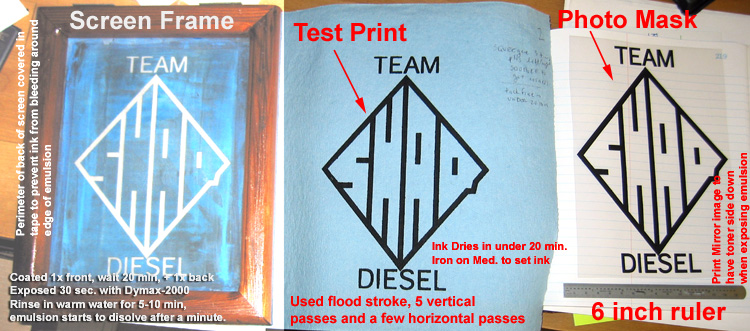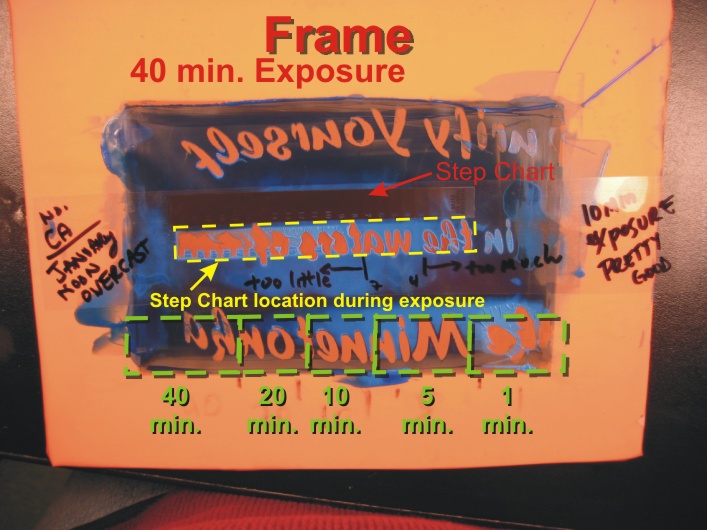- Initial screen printing (Jan 2004):

More recently I've done some messing around making T-Shirts using much nicer photopolymer screen emulsion that I ordered around the time I abandoned screen printing as a viable approach for flexible circuits. The emulsion is from Magestech/Saati (get part number). I used home made screens (made to work quite similarly to screen windows) with polyester screen material. The screen was coated with 3 THIN layers of emulsion (2 on back, 1 on front). The mask was made with transparency film on a laser jet and double printed to get better opacity. The emulsion was exposed for 30 seconds using a Dymax 2000-EC UV lamp (exposure previously established). The screen was rinsed with warm water for 10 minutes (to get off all of the uncured emulsion) and then allowed to dry and exposed for another 30 sec to harden/toughen the emulsion to make a more durable print screen. Pictures of the frame, test print and photo mask are shown below.
This year we made more T-Shirts by the same process, but with finer orange polyester cloth (from Dorn) and using the sun to expose the frames. The following picture shows the test exposure. We used both a Stouffer step chart (Stoufter 21 step sensitivity guide) and the old test strip method from photography. The longest any part of the screen was exposed was for 40 minutes. Test strip exposures were for 1, 5, 10, 20 and 40 minutes each. And the entire test strip area and above were exposed fro 40 minutes. Both the test strip and step chart approaches suggested a 10 minute exposure would be good (for step chart, divide total exposure by the number range that turned out well). However, since we needed to use an acrylic (which can filter out UV light) CD case to hold down the photomask during the final exposure, we added 5 minutes to the exposure to be sure we got enough UV light. This exposure was done in Northern California in January at around noon on an overcast day.
- test exposure screen printing frame (Jan 2005):

- detail picture of exposure (step) chart:

The screen was rinsed with warm water for 5-10 minutes (the emulsion will start disoling in the non-exposed areas after 30-60sec). The screens were blotted with a paper towel after rinsing and set back out in the sun for another 20 minutes to harden (post-cure) the emulsion (this toughens up the screen for printing). It's also nice if you can wait a bit (like an hour or even overnight) before doing your first test print with the screen. When doing a test print, blue shop towels make a good proxy for a cotton T-Shirt and will allow you to see if a bit of emulsion needs to be scraped from the screen before printing shirts.
Overall the screens came out OK, however, the emulsion on one of the screens was too thick, so exposure varied throught the thickness (which was not seen on the screen with a thinner coat). When the emulsion is too think the top side may overcure while the underside under exposes (and may wash away). Also, we should have stayed at 10 minutes for the exposure. Evidently, the CD cover was about as UV transparent as the piece of glass we used during our exposure test. The reason I think this is because thin portions of the lettering for our screen ended up getting overexposed and were hard to was out. This could be a problem with the mask, a problem with light getting under the mask when the CD case was shifted away from these regions, and/or simply overexposing the emulsion (mostly likely the 2nd is the problem, with 3rd condition exaserbating the problem.
-- WillP? - 14 Jan 2005
Ideas, requests, problems regarding TWiki? Send feedback